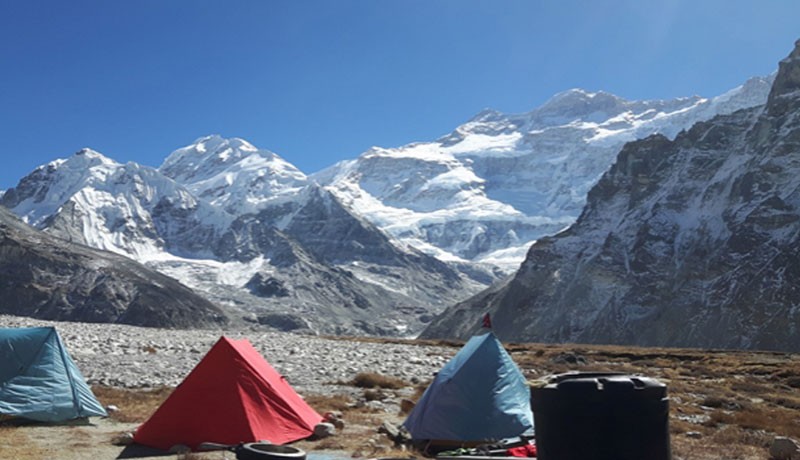About Kanchenjunga Circuit Trek
Mt. Kanchenjunga is the third highest mountain peak in the world. It stands tall at a staggering height of 8586m or 23170 ft, only behind Mt Everest and Mt K2. Kanchenjunga means “five treasures of the great snow” in the Tibetan language. This phrase refers to the five summits that make up the Kanchenjunga range.
Three of the five peaks in the Kanchenjunga range lies in the border of Nepal and Sikkim whereas the other two lies in Taplejung district of Nepal. The Kanchenjunga Circuit Trekking covers diverse geographical regions ranging from subtropical forests to frozen glacial paths. You will pass through many icy glaciers, and mountains pass along the way. The trail stops at various vantage points to overlook the majestic mountain ranges.
Joe Brown and George band were the first to climb the Kanchenjunga mountain on 25 May 1995 successfully. They stopped short few meters ahead of the summit as per the religious beliefs of the locals. Every climber who attempts to climb the Kanchenjunga mountain stops short of the summit as a part of this tradition. The trek is a long and demanding but with proper acclimatization and rest the trek can be completed successfully.
The Kanchenjunga trek is famous for its biodiversity. The conservation area is home to various birds, wild animals, and plants.You will also have an opportunity to explore the villages of Limbu, Rai, Sherpa, and Gurung communities. You will gain first-hand experience of the lifestyle and traditions of such ethnic groups. The local food is not fancy but very nutritious and tasty. You can also taste the famous “Tongba” which is warm homemade alcohol produced by the local and served in a brass ringed wooden pot.
You will pass through alpine shrubs, coniferous forests, meadows, glaciers, mountain passes all in just 24 days. The trip is geographically diverse and rewarding. There are plenty of trekking options available all around Nepal. Everest base camp trek, Annapurna base camp trek, Manaslu trek are some of the popular trekking destinations in Nepal. The Kanchenjunga circuit trek offers a unique off the beaten trekking experience in unexplored territories.
Kanchenjunga is a restricted area and is under a controlled tourism policy by the Nepal government. The trekkers require a special permit to enter the area and a registered trek guide. This is not a bad thing at all; an expert trek guide will aide the trekking process and give insightful local knowledge about the area. The trails fall under the Kanchenjunga Conservation Area (KCA) established in 1998.
If you are a nature lover and want to trek on quiet, off the beaten path then the 25 days Kanchenjunga Circuit Trek is perfect for you. This trek has received some great reviews by avid trekkers all around the world. We offer the exciting Kanchenjunga trek at a reasonable price. Come and experience this trek in the tranquillity of nature and make memories that will last a lifetime. Book your holidays now.
Best Time For The Kanchenjunga Circuit Trek
The best season to trek the Kanchenjunga circuit is the season of spring (March, April, May) and autumn (September, October, November). The weather and the temperature are most favourable in these seasons for trekking.
The autumn season brings in excellent weather, and the views of the mountains are tantalizing. The view of majestic snow-capped mountains on the backdrop of clear blue sky is enchanting. Occasional storms may dump a massive amount of snow in the mountain peaks, adding beauty to the already beautiful environment.
The spring season is also quite favourable for trekking in the region. There are different varieties of wildflowers blooming all over the hills, the rhododendron flowers bloom and paint the trail pink and red.its is mild warmer at lower elevations and moderate temperature at a higher elevation. The bright blue sky gives stunning views of the mountains.
Kanchenjunga circuit is available all around the year. But the monsoon brings heavy rainfall and adds the risk of landslides. The winters are freezing. Some expert trekkers trek during the offseason as well, but it's rather tricky.
The Difficulty of The Kanchenjunga Circuit Trek
The trek of the Kanchenjunga circuit is challenging as there are many ups and downs along the path. The narrow, steep climbs and the narrow pathways make it quite risky. Another critical factor is that the trek is a long one. You walk for 5-7 hours a day on average for about 20 days.
Trekkers usually get exhausted in the middle of the trek. But you don't have to worry. If you have a basic fitness level and a strong mental power, you can complete the trek with ease. There are landslides and avalanches area that you need to cross along the trail. Regular water breaks and protein snacks will help you pass the harsh terrain. However, you will need to be careful to protect yourself from injury and exhaustion.
Note: you may like too visit

